James Webb Space Telescope uncovers starbirth clues at 'cosmic noon' for 33,000 young stars
Using the James Webb Space Telescope, astronomers have gotten close to understanding how early stars formed during cosmic noon, more than 10 billion years ago.

A new image produced by the James Webb Space Telescope (JWST, or Webb) sheds light on how early stars formed during "cosmic noon" more than 10 billion years ago.
About 200,000 light-years away from Earth, the Small Magellanic Cloud, a satellite galaxy and one of the Milky Way's closest neighbors, is notable for lacking metals heavier than hydrogen and helium.
The levels of these metals in the galaxy reflect a uniquely nearby environment to study what galaxies were like during the universe's early history, when it was only two to three billion years old and star formation was at its peak. Although various telescope missions have studied the Small Magellanic Cloud in the past, much remained to be understood.
Now, thanks to Webb's high-resolution imaging, astronomers have discovered more than 33,000 young stars embedded in the NGC 346 nebula, the galaxy's brightest and largest star formation region.
Related: The 1st galaxies may have formed much earlier than we thought, James Webb Space Telescope reveals
"This is sort of minutes on a field to find these things," said Margaret Meixner, an astronomer at the Universities Space Research Association and one of the authors of the study. "That's how powerful James Webb is."
Meixner shared the early imaging results of NGC 346 using Webb on Wednesday (Jan. 11) at the 241st conference of the American Astronomical Society in Seattle.
Breaking space news, the latest updates on rocket launches, skywatching events and more!
"Ribbons of gas and dust"
Cosmic dust is formed when stars and planets are being created, and it hovers in the space between them — the interstellar medium — once their formation process ceases. Being a spinoff of these processes, the dust is made of similar heavy metals as stars and planets. So far, astronomers thought that such heavy elements like carbon, oxygen and iron — all of which are in low concentrations in the Small Magellanic Cloud — are needed to form the dust from which terrestrial planets eventually materialize.
So when astronomers used Webb's powerful near-infrared camera (NIRCam) instrument to study NGC 347, they were surprised to discover "ribbons of gas and dust" in the interstellar medium. This finding is early proof that despite being low on metals, NGC 347 is dusty and has the building blocks necessary to form rocky planetary systems.
Using six of Webb's NIRCam filters, the team found more than 33,000 sources with what they call "IR [infrared] excess." In stars with low masses, dust in surrounding debris disks absorbs starlight and re-emits it at infrared wavelengths. So when astronomers detect infrared emissions, it usually means they have detected dust.
"We were so excited to see the dust around these things," Meixner told reporters at the press conference.
Telescope missions have studied NGC 346 in the past, but this is the first time that astronomers have imaged the dust. For example, the now-retired Spitzer spacecraft found 87 massive young stars in the same region, but it wasn't powerful enough to identify the smaller ones. The Hubble Space Telescope, too, had spotted thousands of pre-main sequence stars that were sprinkled throughout the nebula and connected to each other through gas and dust filaments. However, a lot of these stars went undetected because Hubble wasn't sensitive to the dust surrounding these stars.
JWST is now helping astronomers unveil stars enveloped in dust, and search for the youngest stars by reaching 10 magnitudes below what Spitzer could detect, and two magnitudes fainter than what Hubble is capable of for pre-main sequence stars. Searching for star-forming regions in infrared wavelengths has allowed astronomers to discover many stars that are not visible, or are incorrectly identified at optical wavelengths.
In the coming months, astronomers hope to learn how the star formation process in the Small Magellanic Cloud is similar or different from what we have learnt from our own. They also plan to continue observing protostars in the region. These stars grow in size and composition by sucking surrounding dust, so it remains to be seen how much of the dust spotted now by Webb survives the star formation process, and ultimately if what remains is sufficient to form rocky planets.
For now, JWST has already unveiled a mammoth number of new young stars, and astronomers say they are just getting started.
"We have just scratched the surface of this data," said Meixner. "We are going to go back and push it down to [almost] brown dwarf limits to see what we can find."
The research is also described in a paper published Jan. 10 in the preprint server arXiv.
Follow Sharmila Kuthunur on Twitter @Sharmilakg. Follow us on Twitter @Spacedotcom and on Facebook.
Join our Space Forums to keep talking space on the latest missions, night sky and more! And if you have a news tip, correction or comment, let us know at: community@space.com.

Sharmila Kuthunur is an independent space journalist based in Bengaluru, India. Her work has also appeared in Scientific American, Science, Astronomy and Live Science, among other publications. She holds a master's degree in journalism from Northeastern University in Boston.

